Being able to vacuum a pool is probably one of the most important skills to learn when you have a pool built or buy a house with an existing pool. What I mean by vacuum is using a manual pool vacuum, not an automatic or robotic pool cleaner.
To vacuum a pool with a sand filter, you will need a vacuum head, a pool pole and a vacuum hose. You connect the vacuum hose to the suction side of the pool, normally at the bottom of the skimmer. Then gently move the vacuum around the bottom of the pool, sucking up the dirt as you go.
That is, of course, a very simplified explanation.
For full instructions, use the easy-to-follow step-by-step guide on how to vacuum a pool with a sand filter below. This guide largely applies to both inground and above-ground pools. These instructions also apply to how to vacuum an above-ground pool with a sand filter.
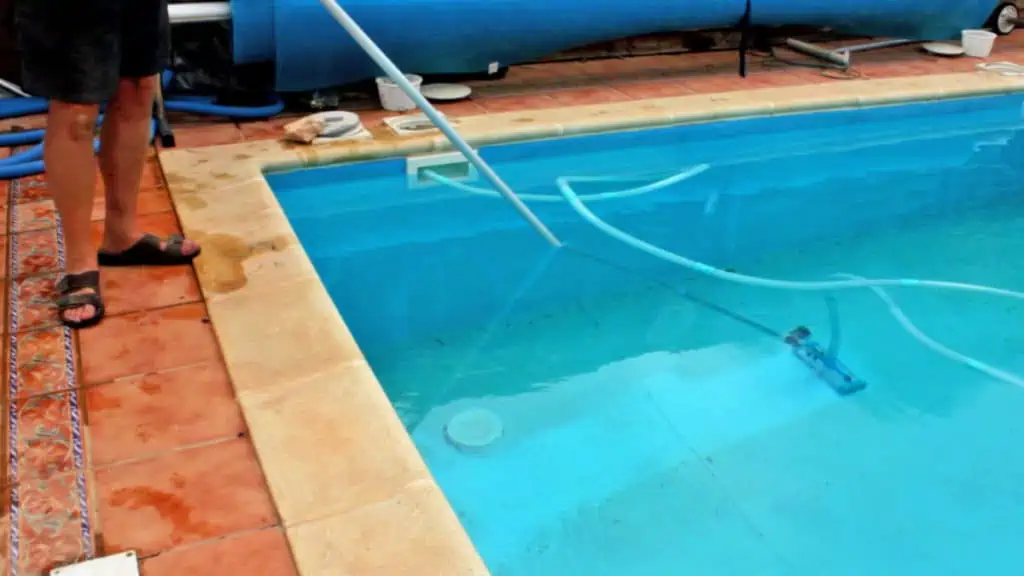

Vacuuming a pool – step by step
These steps cover how to vacuum a pool with a sand filter on the filter setting. If you need to vacuum on the waste setting, because the pool is very dirty, then I have a separate post – How to vacuum to waste.
1. Brush the pool sides
To ensure any dirt on the sides of the pool is also cleaned, it is good practice to go around the pool and brush the sides to allow dirt to fall to the bottom.
2. Use a pool net
Use a pool net to carefully pick up as much of the large dirt from the bottom of the pool as possible. This includes leaves, small stones and other debris that may clog up the filter baskets. Small pieces of debris can be left for the vacuum to pick up. Try not to disturb the small particles of dirt too much.
TIP: After brushing and using the net, leave the pool for an hour or so to allow any fine dirt to settle. The vacuum will not pick up any floating in the water, so you may still have some dirt on the bottom the next day if you don’t give it a chance to settle.
3. Attach the pool vac to the vacuum pole
Attach the vacuum head you intend to use securely to the pool pole.
4. Connect the hose to the vacuum
Connect the hose to the fitting on top of the pool vacuum head and lower the vacuum into the pool near the skimmer until it reaches the bottom.
5. Remove air from the hose
Feed the rest of the pool hose pushing it straight down into the pool to remove the air – see How to remove air from the pool hose.
6. Connect the hose to the skimmer inlet
This will be done in one of three ways:
- directly into the inlet at the bottom of the skimmer (after removing the skimmer basket)
- using a skimmer vacuum plate
- if you have one then connect it to the dedicated vacuuming inlet at the side of the pool
7. Move multiport valve to filter
If it is not already on the filter setting, push down on the handle and move it to the filter setting.
8. Switch the pump on
Switch the pool pump back on at the electrical panel. Before you start to vacuum, ensure that any air is removed from the system and that water is pumped.
TIP 1: You may need to increase the amount of suction to the vacuum. You can turn the suction side valves so the bottom drain and other skimmers are off. When finished, remember to put them back to their original positions.
TIP 2: If you have more than one skimmer but cannot switch them off individually, you can take a tennis ball and push it down into the other skimmer to block the hole to the pump. The suction will hold it there.
9. Start to vacuum
Begin vacuuming by slowly moving the vacuum along the bottom of the pool. You must try to do this as gently as possible to ensure you don’t disturb the dirt on the bottom. Any that you do disturb is likely to go into suspension in the water and settle again later, meaning you will have to vacuum again.
I try to operate methodically. I normally start in one corner. I vacuum along the side in the direction I intend to work, then come back and vacuum from the side to the middle of the pool. I work along the pool to the other end and then do the same on the other side.
10. Turn off the pump and disconnect the hose
Turn off the pump and remove the hose from the skimmer or suction port. Then, remove the vacuum from the pool.
11. Backwash the filter
If there was little dirt in the pool, this may not be necessary. If it is, turn the multiport valve to backwash and then switch the pump on again for a few minutes. You should be able to see the dirt and debris swirling in the viewing glass as it is expelled (if you have a valve on the outlet line, make sure it is open).
When the water starts to run clear, you can switch the pump off and rinse the multiport valve. Again, turn on the pump and run it for about a minute. Then, pump off again and return the valve to the filter. For full details on backwashing, read my article – How to backwash a pool – a step by step guide
12. Empty the pump strainer basket
You should be able to see through the strainer basket’s clear cover. If you can see that there are leaves and other debris in there, remove the cover, pull off the basket and empty it before putting it back on and putting the cover back on.
13. Switch the pump back on – you are finished
Your pool should now be nice and clean. So swim and relax!
When vacuuming a pool, what setting should the filter be on?
Many pool owners ask what setting to vacuum the pool with a sand filter. When you vacuum a pool, the multiport valve of your sand filter will need to be on one of the following two settings:
Filter
The filter setting is the one you will need to vacuum on the most often. When there is not too much dust or other debris on the bottom of the pool, this is the setting you should use.
When the multiport valve is set to Filter, the water that is sucked up through the vacuum head will pass through the filter to remove any dust or other debris in the water before then returning to the pool.
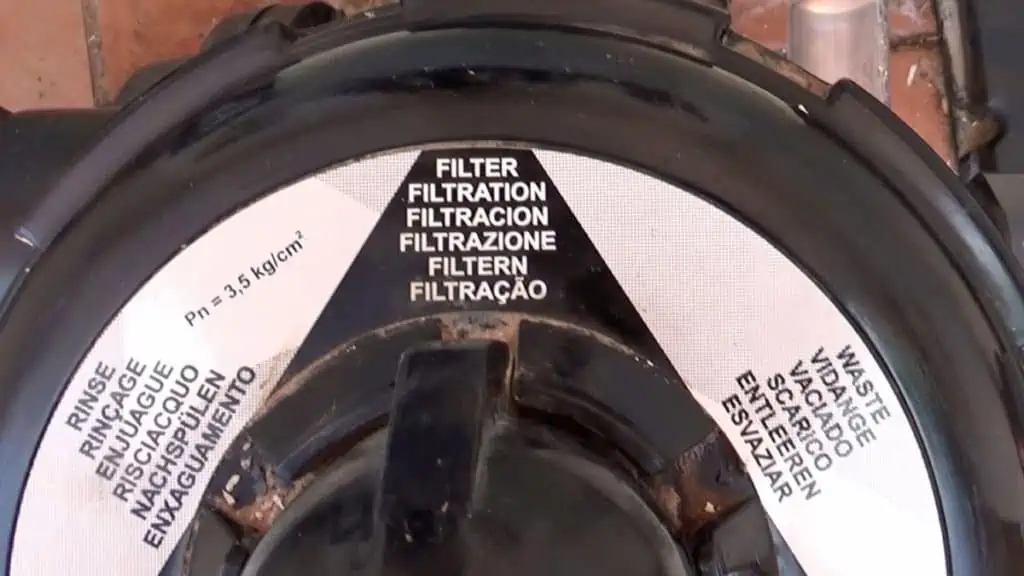
Waste
You will only need to vacuum the pool on the waste setting when there is too much debris for the filter to cope with. This includes dead algae (known as algae dust) if you have had an algae infestation that has been dealt with by shocking.
When you vacuum on waste, the water neither passes through the filter nor returns to the pool. Instead, it is sent out of the pool outlet pipe into your yard or wherever it is sent.
Read: How to vacuum to waste
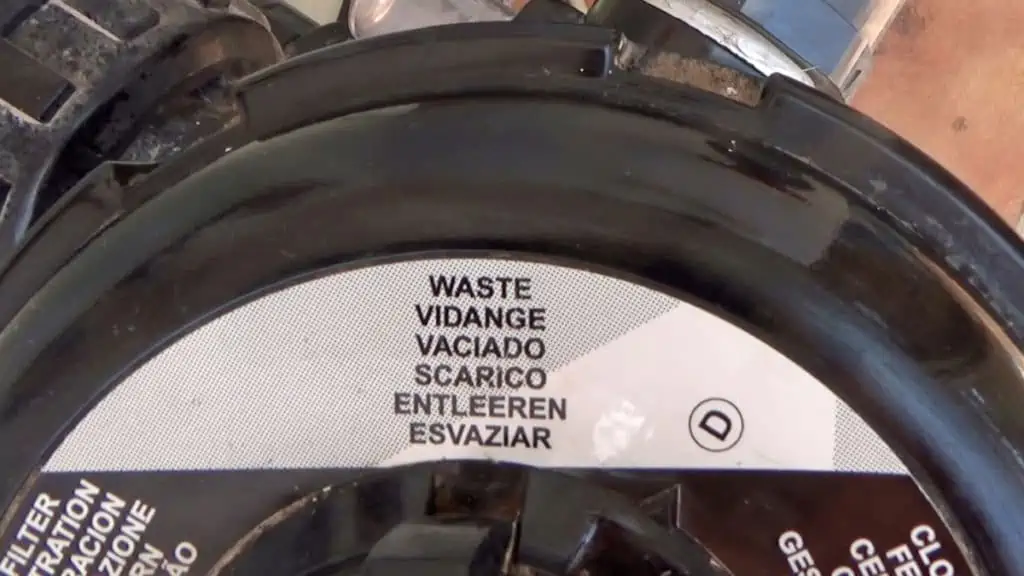
My article All the pool filter settings explained goes into this in more detail.
The tools you will need to vacuum the pool
You do not need many tools to vacuum manually. You only need the following:
Best alternative to manually vacuuming
If all of the above sounds too much like hard work, then there is a more expensive but simple solution ….. a robotic pool cleaner
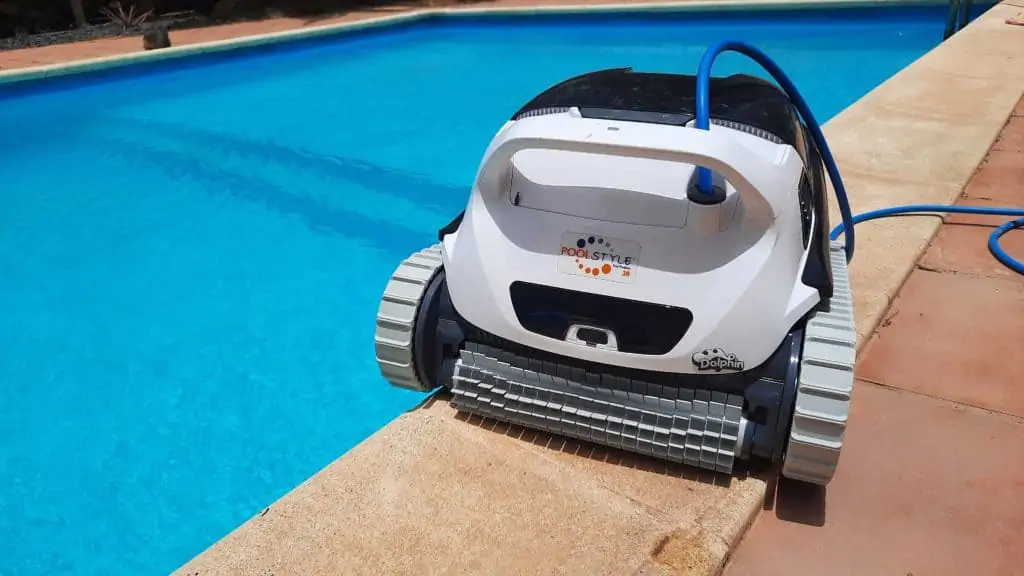
Having bought a robotic pool cleaner myself, I can honestly say that I wish I had bought one much sooner. I spent almost seven years manually vacuuming my pool every week, which probably equates to over 500 hours of time that I could have spent doing something more enjoyable. Now, I just drop my robot into the pool, switch it on, and that’s it.
The most popular model is the Dolphin Nautilus CC Plus, which is available on Amazon. It cleans the bottom of the pool, the sides, and the waterline.
Low suction when vacuuming pool
When vacuuming on the filter setting, after a while, you may notice a significant loss of suction.
If this happens, it is probably because the filter has become clogged with the dirt you are vacuuming. This causes an increase in back pressure in the filter, which in turn leads to a reduction in suction.
In this case, you must backwash the filter to clear it and regain the suction.

Can I vacuum sand in the bottom of my pool?
You can vacuum sand from the bottom of your pool as you would normally.
However, it would be best to establish why you have sand there in the first place. If you live in a very sandy place, so sand gets blown in regularly, or you have just returned from the beach with your kids and they jumped straight in the pool, then there is your answer and there is no need to worry.
But if there is no apparent reason for sand in the pool, it may be because your sand filter is damaged. Either the standpipe (the pipe that runs through it) or the laterals (which act like a sieve at the bottom of the filter) are probably damaged and must be replaced.
If that is the case, you may as well check and change the sand in the pool filter, too.
Do you leave the skimmer basket in when you vacuum a pool?
This depends on whether or not you will be connecting the vacuum hose to the hole at the bottom of the skimmer, to a vacuum plate or to a dedicated vacuum port.
If you will be connecting to the hole at the bottom then you have no alternative but to remove the skimmer basket when vacuuming otherwise you will not have access to it.
If using a vacuum plate, as this attaches above the skimmer basket, the basket can be left in situ. This has the advantage of any large debris that is sucked up by the vacuum will be trapped in the skimmer basket rather than the pool pump strainer basket.
If you will use a dedicated vacuum port on the side of the pool, the skimmer basket can stay in place.
Why does my pool get cloudy when I vacuum it?
The two most likely explanations for it getting cloudy when you vacuum a pool are:
- You are trying to vacuum too quickly so instead of the vacuum head sucking up the dirt it is being disturbed and going into suspension in the water. Try slowing down. I would say that I move the vacuum head along the bottom of the pool at a speed of approximately one second per foot.
- You do not have sufficient suction so the vacuum cannot pick up all of the dirt. Try to increase the suction by:
- Closing all valves to the pump except the skimmer you are using.
- If you have more than one skimmer, but only one valve, then push a tennis ball into the hole of the skimmer you aren’t using to cut off the flow. This will increase the flow/suction in the skimmer you are using.
- Try backwashing the filter as it may be very dirty, reducing the flow through it.
Read: My pick of the best pool vacuum heads
Do I need to backwash my sand filter after vacuuming the pool?
Yes, it’s advisable to backwash your sand filter after vacuuming, especially if you’ve collected a significant amount of debris. Backwashing cleans the filter media by reversing the water flow, flushing out trapped dirt and contaminants, which helps maintain filtration efficiency.
Should I vacuum on the “Filter” or “Waste” setting on my sand filter?
Filter Setting: Use this when the pool has minimal debris. The water passes through the filter media, trapping dirt before returning clean water to the pool.
Waste Setting: Use this when vacuuming large amounts of debris, algae, or fine particles. The dirty water bypasses the filter and is expelled directly out of the waste line, preventing the filter from clogging.
How often should I vacuum my pool?
It’s recommended to vacuum your pool at least once a week to maintain optimal cleanliness. However, the frequency may increase after storms, heavy use, or when you notice visible debris and dirt accumulating.
Can I use an automatic pool cleaner with a sand filter?
Automatic pool cleaners like suction-side, pressure-side, or robotic cleaners can be used with a sand filter. Suction-side cleaners connect similarly to manual vacuums, while pressure-side and robotic cleaners operate independently but still benefit from the filtration provided by the sand filter.
How does vacuuming affect my pool’s chemical balance?
Vacuuming can slightly alter your pool’s chemical balance by removing water and contaminants. After vacuuming, it’s a good practice to:
Test the Water: Check pH, chlorine levels, and alkalinity.
Adjust Chemicals as Needed: Balance the water chemistry to maintain safe and comfortable swimming conditions.
How do I troubleshoot loss of suction when vacuuming?
Check for Air Leaks: Ensure all hose connections are tight and the hose is free of cracks.
Inspect the Skimmer Basket and Pump Basket: Remove any debris that might be blocking water flow.
Examine the Filter: A clogged filter can reduce suction; backwash if necessary.
Look at the Impeller: Debris stuck in the pump impeller can impede water flow.

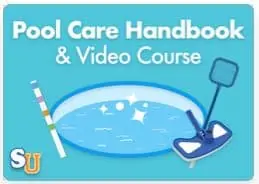

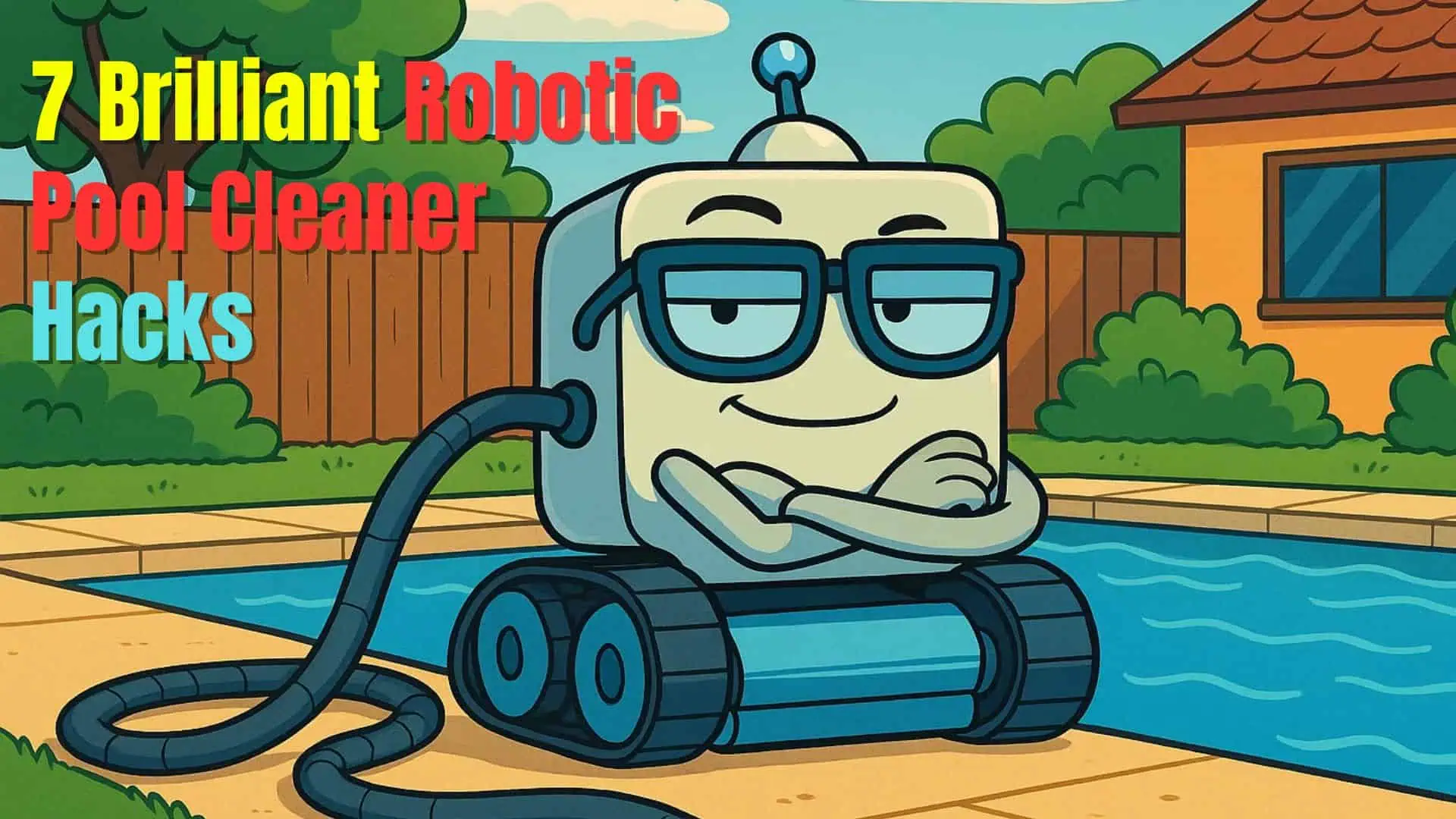


Leave a Reply